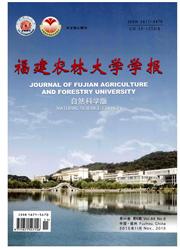

 中文摘要:
中文摘要:
采用静态箱式法对中亚热带杉木人工林、马尾松人工林和楠木人工林的土壤呼吸进行野外测定,比较分析了3种森林类型土壤呼吸作用及其与温度和土壤含水量的相关关系.结果表明:不同森林类型的土壤呼吸作用强弱存在显著差异,表现为楠木人工林〉杉木人工林〉马尾松人工林,但3种人工林土壤呼吸作用的季节和日变化比较明显,其动态与气温的变化大体一致,均表现为单峰型,高峰值出现在7月份和14:00;3种森林类型的土壤呼吸作用均与温度有较好的指数关系,尤其与5cm地温的相关性最好,且以杉木人工林的Q10值最大,说明杉木人工林土壤呼吸对温度变化的敏感性最强;0-20cm土壤含水量与土壤呼吸有较好的线性关系;5cm地温和0-20cm土壤含水量较之温度或湿度能更好地解释土壤呼吸的变化,说明土壤呼吸受到温度和水分的协同作用。
 英文摘要:
英文摘要:
The dynamics of the soil respiration in Phoebe bourmei plantation, Cunninghamia lanceolata (Lamb.) Hook plantation and Pinus massoniana plantation were measured by the enclosed chamber method to compare and analyze its relationship to temperature and soil water. The results showed that there was significant difference in soil respiration among the various forest types and the highest was in Phoebe bourmei plantation, followed by C. lanceolata, and the lowest was in Pinus massoniana plantation. However, the seasonal and daily pattern of soil respiration in three forest types could be expressed as a one-humped curve, and the highest values appeared in July and at 14:00, which was similar to the change of air temperature. There was an exponent correlation between the soil respiration and temperature, especially the soil temperature at 5 cm depth. The Q10 value of Chinese fir plantation was higher than that of the other two, which implied that the sensitivity of soil respiration to temperature in Chinese fir plantation was highest. There was a linear correlation between soil respiration and the soil water content in the upper 20 cm of soil. The relationship between soil respiration rate and the two variables of the soil temperature at 5 cm depth and the soil water content in the upper 20 cm of soil could be described with the multiple linear regression equation, which had much more predicative power than that using temperature or soil water content as single independent variables, and it was proved that the soil respiration was affected by both temperature and moisture.
 同期刊论文项目
同期刊论文项目
 同项目期刊论文
同项目期刊论文
 期刊信息
期刊信息
